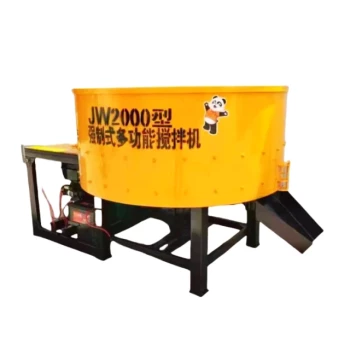Overloading a cement mixer can lead to several operational and mechanical problems, impacting both the quality of the mix and the longevity of the equipment. Key issues include reduced mixing efficiency, motor strain, uneven mixing, and potential mechanical failures. These problems can compromise construction timelines and increase costs due to repairs or replacements.
Key Points Explained:
-
Reduced Mixing Efficiency
- Cause: Overloading exceeds the mixer's designed capacity, limiting the space for materials to move freely.
- Effect: Clumping or incomplete blending of cement, sand, and aggregates, leading to weak or non-uniform concrete.
- Purchaser Consideration: Ensure the mixer's capacity aligns with project needs to avoid inefficiencies.
-
Motor Strain and Overheating
- Cause: Excess weight forces the motor to work harder, increasing electrical resistance and heat buildup.
- Effect: Shortened motor lifespan, frequent breakdowns, or complete burnout.
- Purchaser Consideration: Opt for mixers with overload protection or higher horsepower for heavy-duty use.
-
Uneven Mixing
- Cause: Overcrowding prevents proper agitation, leaving dry pockets or poorly integrated additives.
- Effect: Structural weaknesses in concrete, risking cracks or failures in construction.
- Purchaser Consideration: Prioritize mixers with optimized drum designs for consistent results.
-
Mechanical Wear and Tear
- Cause: Excessive load stresses bearings, gears, and the drum frame.
- Effect: Premature part failures, unplanned downtime, and higher maintenance costs.
- Purchaser Consideration: Look for robust builds with easy-to-replace components.
-
Safety Risks
- Cause: Overloaded mixers may tip or destabilize, especially on uneven terrain.
- Effect: Workplace accidents or damage to surrounding materials.
- Purchaser Consideration: Choose models with stability features like reinforced bases or locking wheels.
For purchasers, selecting the right cement mixer involves balancing capacity, durability, and safety features to match project demands while avoiding overloading pitfalls.
Summary Table:
| Issue | Cause | Effect | Purchaser Consideration |
|---|---|---|---|
| Reduced Mixing Efficiency | Overloading limits material movement | Clumping, weak concrete | Match mixer capacity to project needs |
| Motor Strain | Excess weight forces motor to overwork | Overheating, burnout, frequent breakdowns | Choose mixers with overload protection or higher horsepower |
| Uneven Mixing | Overcrowding prevents proper agitation | Dry pockets, structural weaknesses | Opt for mixers with optimized drum designs |
| Mechanical Wear | Excessive load stresses bearings, gears, and frame | Premature failures, downtime, higher costs | Prioritize robust builds with replaceable parts |
| Safety Risks | Overloaded mixers may tip on uneven terrain | Workplace accidents, material damage | Select models with stability features (reinforced bases, locking wheels) |
Need a reliable cement mixer for your construction project?
Overloading can lead to costly downtime and safety hazards. At GARLWAY, we provide durable, high-performance cement mixers designed to handle your workload without strain. Our equipment ensures even mixing, reduced maintenance, and enhanced safety—so your projects stay on schedule.
Contact our experts today to find the perfect mixer for your needs!
Related Products
- HZS75 Concrete Batching Plant Cement Mixer Price Concrete Mixer Bunnings Mixing Plant
- Concrete Cement Mixer Machine Drum Mixer for Construction
- Auto Concrete Cement Mixer Machine New
- JZC1000 Industrial Concrete Mixer Machine Cement Mixer Price
- HZS25 Best Cement Mixer for Quick Mix Concrete at Bunnings
People Also Ask
- Can you mix mortar in a cement mixer? Pros, Cons & Best Practices
- How much does a batching plant cost? Pricing Guide for Concrete Mixing Plants
- How does ready-mix work? The Science Behind Efficient Construction
- What are the disadvantages of ready mixed concrete? Key Challenges Explained
- How do I choose a cement mixer? Find the Perfect Mix for Your Project



















